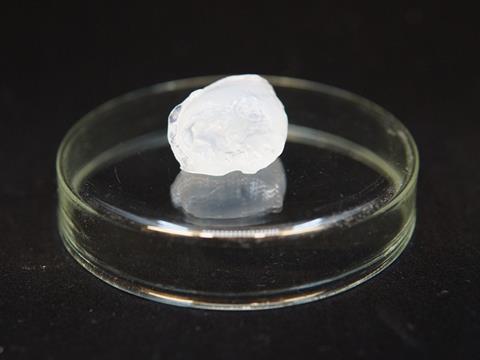
Metsä Group’s innovation arm, Metsä Spring, is leading a €1 million seed funding round in Swedish start-up FineCell to help develop and plan a demo production facility for its technology, which converts dry pulp fibre into added-value biomaterial.
The patent-protected technology brings together pulp-based cellulose and oxalic acid – a natural chemical found in rhubarb, for example – and produces CellOx, a biobased material that apparently requires between 80% and 90% less energy to manufacture.
Said to be lighter to ship, it can be stored in a solid form and applied as a powder or as a water solution, also known as hydrogel. It is claimed that the transition between solid and liquid is ‘very energy-efficient’ with FineCell technology.
CellOx is also transparent, which is hoped to widen its potential uses. These include thin and flexible films; it is also applicable in various creams for such sectors as beauty and healthcare, as well as in the commercial production of paint, as a binding agent – and, therefore, a replacement for fossil-based chemicals.
“The world is scrambling to replace fossil-based materials with sustainable ones,” says Dr. Peter Axegård, CEO and co-owner of FineCell. “Our product, based on softwood pulp from sustainably managed Nordic forest, gives many industries an alternative to the components they are currently using.
“Metsä Spring has seen the potential in our innovation, and due to their know-how in planning, constructing and operating production plants, including pilots and demos, and their access to the raw material linked to their ambition to upgrade Nordic wood, they were the perfect choice to support us as we move forward.”
“We’ve been following FineCell for some time and are delighted to now be part of their journey,” Niklas von Weymarn, CEO of Metsä Spring, continues. “For us, all technologies that convert softwood pulp into added-value products are of interest. This technology and product clearly stand out, making it especially interesting.
“The FineCell technology is still young. At this stage, we do not yet know all the directions that this platform might take us.”
FineCell plans to finish the design phase of its demo plant by the end of 2024. A larger-scale test production is scheduled for 2025, and full commercial production is expected in 2027.
Several meetings have reportedly taken place with large brands aiming to improve the sustainability of their consumer products. Additionally, the investment funds will be used to boost material application research.
“Our goal is to bring our biobased material to more and more sectors, thus replacing fossil-based materials and also increasing the performance of the product,” Axegård concludes. “This, in turn, would require scaling up production to the point where we are making a large impact on products people use in their everyday lives.
“Our story has just begun, and we cannot wait to embark on the next stage in our journey.”
FineCell is a spinout of the KTH Royal Institute of Technology in Stockholm, Sweden, and Metsä Spring leads a group of investors, including EIT InnoEnergy and the company’s founder.
Earlier this year, Metsä Spring led a seed funding round that assisted Fiberwood, a Finnish start-up and producer of insulation and packaging materials from side streams of the mechanical wood industry, with the scale-up of production capabilities at its pilot plant.
More recently, it provided Montinutra with €2 million in pre-A funding to upscale its conversion of forest industry side streams into natural biochemicals for the chemical and cosmetics sectors.
Metsä Group’s bioproduct mill and paperboard mill expansion in Kemi have also commenced their operations. Pulp deliveries to customers began in October.
If you liked this article, you might also enjoy:
The L’Oréal approach to packaging sustainability
What steps is Apple taking to make its packaging more sustainable?
How did Brazil achieve its 100% aluminium can recycling rate – and can it be replicated in the EU?
Experts have their say on the EU’s Packaging and Packaging Waste Directive revisions











No comments yet